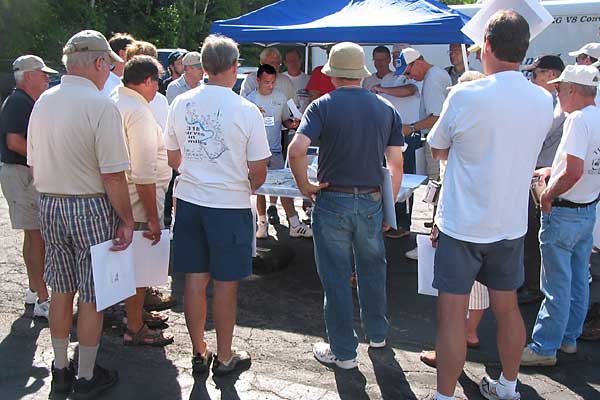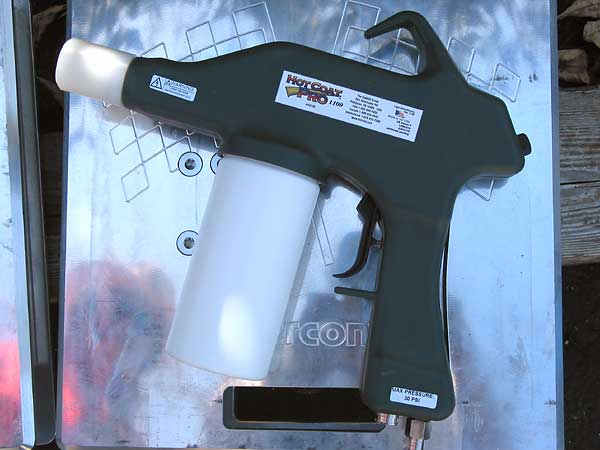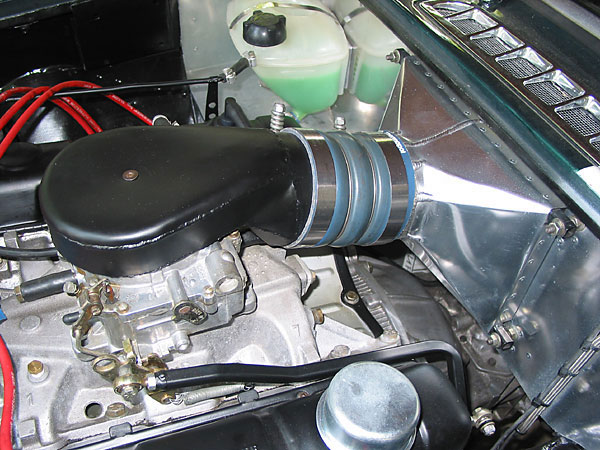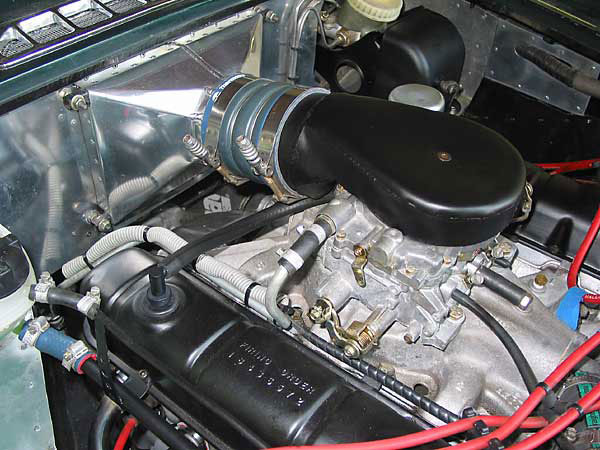
Pete Mantell's tech session on powder coating
British V8 2007 Tech Session: Powder Coating 101
as published in British V8 Newsletter, Volume XV Issue 2, September 2007presented by: Pete Mantell of Mantell Motorsport coverage by: Curtis Jacobson
For several years Pete Mantell has been giving British V8 Meet tech-sessions and also writing articles for this newsletter on the subject of Small Block Ford based MGB engine conversions. Yes, Pete is expert on that subject... but he also runs a successful media-blasting and powder-coating business! On Saturday morning at 10am, Pete presented Powder Coating 101 to a "standing room only" crowd. I think a lot of people have been curious to hear pointers on powder coating. The information Pete laid out is relevant and useful to anyone who is either (a) thinking of sending out some parts to have a durable powder coat finish applied, or (b) thinking of investing in some equipment and trying their hand at do-it-yourself powder coat finishing.
As we've come to expect, Pete was very well prepared. In fact, he handed out literature packets to all attendees so that we didn't have to take notes! I've reproduced Pete's prepared notes below, and then at the end I've added some notes anyway from when Pete got off script and when he got into questions-and-answers.
Pete's Prepared Remarks
So you've heard of it, but you're not sure exactly what powder coating is. According to the Powder Coating Institute's web page, "Powder coating is an advanced method of applying a decorative and protective finish to a wide range of materials and products that are used by both industries and consumers. The powder used for the process is a mixture of finely ground particles of pigment and resin, which is sprayed onto a surface to be coated. The charged powder particles adhere to the electrically grounded surfaces until heated and fused into a smooth coating in a curing oven. The result is a uniform, durable, high-quality and attractive finish." There, so now you know! Or do you?
Pete's HotCoat Pro powder coating gun from Eastwood Company
Why is powder coating better?
It's more durable. Powder coating provides one of the most economical, long-lasting and color-durable finishes available. Properly powder coated surfaces are more resistant to chipping, scratching, fading, and wearing than many other alternative finishes. Color selection is virtually unlimited, and both high and low gloss are available as well as metallic and clear finishes. Thanks to the UV resistance of many of the powders, colors stay bright and vibrant longer. Texture selections range from smooth surfaces to wrinkled and matte finishes. Rougher textures are available for hiding surface imperfections.
Protects the Environment
Powder coating is also highly protective of our environment. While liquid finishes contain solvents which have pollutants known as volatile organic compounds (VOCs), powder coating contains no solvents and releases negligible amounts, if any, of VOCs into the atmosphere. Thus, there is no longer a need for finishers to buy costly pollution control equipment. In addition, most powder coating overspray that does not adhere to the part can be retrieved and reused. Although this is not always practical for many low-volume users like me, for some users this can virtually eliminate the waste commonly found in liquid finishing processes.
Saves Money
Elimination of VOCs and reduction of wastes saves money and helps companies comply more easily and economically with the regulations of the U.S. Environmental Protection Agency. In fact, one of the major elements in expanding the market for powder coating has been the implementation over the past 30 years of stringent air pollution control legislation.
Powder coating is also highly protective of our environment. While liquid finishes contain solvents which have pollutants known as volatile organic compounds (VOCs), powder coating contains no solvents and releases negligible amounts, if any, of VOCs into the atmosphere. Thus, there is no longer a need for finishers to buy costly pollution control equipment. In addition, most powder coating overspray that does not adhere to the part can be retrieved and reused. Although this is not always practical for many low-volume users like me, for some users this can virtually eliminate the waste commonly found in liquid finishing processes.
Saves Money
Elimination of VOCs and reduction of wastes saves money and helps companies comply more easily and economically with the regulations of the U.S. Environmental Protection Agency. In fact, one of the major elements in expanding the market for powder coating has been the implementation over the past 30 years of stringent air pollution control legislation.
Where is Powder Coating Used?
The appliance and architectural supply industries have been leaders, but the automotive industry is also a big user of powder coating. Conversion from liquid to powder clearcoats for auto body exteriors is moving rapidly. Powder topcoats resist acid rain, the sun's ultraviolet rays and road and weather damage, helping cars retain their "showroom look" much longer and improving their resale value. BMW and Volvo are using powder coating on some of their new model cars. GM, Ford and Daimler-Chrysler have formed a consortium to test this technique on production lines.
Powder coating has made substantial inroads as a primer for car, van, and pickup truck bodies in the United States. Auto body primers in colors will be next.
There is a huge potential market for high-heat resistant powder coatings on aftermarket mufflers, to resist corrosion, protect against nicks, and prolong the life of the muffler. Some companies are already applying heat-resistant powder to aftermarket mufflers, and the new car market is thought to be two or three years away.
Powder coating is also applied to wheels, grilles, bumpers, door handles, roof racks, and exterior and interior trim. "Under the hood" uses include oil and fuel filters, brake pads, engine block casings, suspension components and radiators. Pickup truck and SUV owners purchase powder coated side steps, bed rails, luggage racks, and toolboxes as dealership add-ons or in aftermarket stores and catalogs.
Performance car owners can find powder coated special suspension units, carburetor parts and valve covers, plus flashy rear view mirror mounts and other exterior adornments.

All of the satin black components in this picture were media blasted and powder coated by Pete.
If you're not familiar with the term "media blasting", just think "sand blasting" except that the abrasive particles used aren't necessarily sand. In fact, Pete said he uses glass bead abrasive powder for almost everything he media blasts. (There are certain situations where other media such as crushed walnut shells or aluminum oxide grit work better, but glass bead is the most versatile of media. Incidentally, Pete specifically warned "Don't ever use aluminum oxide grit to blast aluminum because the grit gets imbedded and is about impossible to remove. You can't get a smooth powder coat finish over the aluminum oxide grit.)
Pete showed us a couple engine valve covers. One of them he had challenged his apprentice to clean as thoroughly and carefully as he could with chemical degreasers. Even after scrubbing and scrubbing, apparently the valve cover wasn't truly clean because when Pete applied a powder coating over it, the finish was horrible: blotchy, discolored, and with uneven smoothness.
After media blasting, dust needs to be removed from the substrate. You can wipe it off with a rag. Eastwood's "PRE", which comes in an aerosol can, is handy at this stage because it will also remove any traces of dirt, wax, grease, or silicone that may remain on the surface.
What about masking? First of all, special masking tape is available that's designed specifically to withstand the heat of the powder coating oven and still be removable. With masking tape it's possible (although difficult) to layer up multiple colors of powder coating. On the other hand, one of the charms of powder coating is that masking is typically a bit less of an issue than with paints. After applying the powder, but before heating in the oven, the powder (e.g. "overspray") can simply be wiped off of any surface where it's not wanted.
Although people don't seem to talk about it so much, you can also use familiar techniques to "improve" the powder coat finish after it cures: buffing, color sanding, etc.

Eastwood epoxy powder, color code number 11869 "flat black", as applied by Mantell Motorsport

Engine compartment parts, suspension parts, brake system parts...
Editor's note: I hired Pete to blast and powder-coat a big batch of MGB V8
parts for me this summer. The finish completely met my expectation, as I knew
it would. Even more important to me, Pete provides exceptional, quick, hassle-free
service. Great communication and careful packaging too. Give Pete a call when
you need something powdercoated!
Disclaimer: This page was researched and written by Curtis Jacobson. Views expressed are those of the author, and are provided without warrantee or guarantee. Apply at your own risk.
Photos by Curtis Jacobson. All rights reserved.
The appliance and architectural supply industries have been leaders, but the automotive industry is also a big user of powder coating. Conversion from liquid to powder clearcoats for auto body exteriors is moving rapidly. Powder topcoats resist acid rain, the sun's ultraviolet rays and road and weather damage, helping cars retain their "showroom look" much longer and improving their resale value. BMW and Volvo are using powder coating on some of their new model cars. GM, Ford and Daimler-Chrysler have formed a consortium to test this technique on production lines.
Powder coating has made substantial inroads as a primer for car, van, and pickup truck bodies in the United States. Auto body primers in colors will be next.
There is a huge potential market for high-heat resistant powder coatings on aftermarket mufflers, to resist corrosion, protect against nicks, and prolong the life of the muffler. Some companies are already applying heat-resistant powder to aftermarket mufflers, and the new car market is thought to be two or three years away.
Powder coating is also applied to wheels, grilles, bumpers, door handles, roof racks, and exterior and interior trim. "Under the hood" uses include oil and fuel filters, brake pads, engine block casings, suspension components and radiators. Pickup truck and SUV owners purchase powder coated side steps, bed rails, luggage racks, and toolboxes as dealership add-ons or in aftermarket stores and catalogs.
Performance car owners can find powder coated special suspension units, carburetor parts and valve covers, plus flashy rear view mirror mounts and other exterior adornments.

All of the satin black components in this picture were media blasted and powder coated by Pete.
Pete's Extemporaneous Remarks
The main, recurring topic of the Pete's remarks was regarding the importance of properly preparing all surfaces before powder coating. If the underlying surface is dirty, rough, or uneven, you must expect inferior results. Almost all the parts Pete powder coats first get media blasted.If you're not familiar with the term "media blasting", just think "sand blasting" except that the abrasive particles used aren't necessarily sand. In fact, Pete said he uses glass bead abrasive powder for almost everything he media blasts. (There are certain situations where other media such as crushed walnut shells or aluminum oxide grit work better, but glass bead is the most versatile of media. Incidentally, Pete specifically warned "Don't ever use aluminum oxide grit to blast aluminum because the grit gets imbedded and is about impossible to remove. You can't get a smooth powder coat finish over the aluminum oxide grit.)
Pete showed us a couple engine valve covers. One of them he had challenged his apprentice to clean as thoroughly and carefully as he could with chemical degreasers. Even after scrubbing and scrubbing, apparently the valve cover wasn't truly clean because when Pete applied a powder coating over it, the finish was horrible: blotchy, discolored, and with uneven smoothness.
After media blasting, dust needs to be removed from the substrate. You can wipe it off with a rag. Eastwood's "PRE", which comes in an aerosol can, is handy at this stage because it will also remove any traces of dirt, wax, grease, or silicone that may remain on the surface.
What about masking? First of all, special masking tape is available that's designed specifically to withstand the heat of the powder coating oven and still be removable. With masking tape it's possible (although difficult) to layer up multiple colors of powder coating. On the other hand, one of the charms of powder coating is that masking is typically a bit less of an issue than with paints. After applying the powder, but before heating in the oven, the powder (e.g. "overspray") can simply be wiped off of any surface where it's not wanted.
Although people don't seem to talk about it so much, you can also use familiar techniques to "improve" the powder coat finish after it cures: buffing, color sanding, etc.

Eastwood epoxy powder, color code number 11869 "flat black", as applied by Mantell Motorsport

Engine compartment parts, suspension parts, brake system parts...
Disclaimer: This page was researched and written by Curtis Jacobson. Views expressed are those of the author, and are provided without warrantee or guarantee. Apply at your own risk.
Photos by Curtis Jacobson. All rights reserved.

